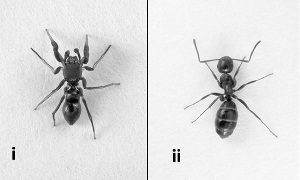Ant-Mimicking Spider Relies on a “Double-Deception” Strategy to Fool Different Audiences
From snakes that look like they have two heads to color-shifting chameleons, deception is at the heart of many animals’ survival strategies. Both visual and chemical predator deterrence are well-documented phenomena in the animal world, but new research on ant-mimicking spiders, published in PLOS ONE, may be the first documented case of a species that uses visual deception to elude one group of predators, and chemical deception to escape another.
Ant mimicry, or myrmecomorphy, is a tactic used by numerous spider species, and with good reason, since many predators steer clear of preying on ants due to their aggressive tendencies and often unpleasant taste. Ant-mimicking spiders can have body shapes that closely resemble those of ants, as well as colored patches that look like ant eyes. Combine these characteristics with behaviors such as waving their front legs in the air to resemble probing ant antennae, and these spiders can successfully convince predators to look elsewhere for their next meal. The jumping spider Peckhamia picata is one such ant mimic whose visual signals are an effective deterrent for visually focused predators, such as other species of jumping spiders. The picture below shows a jumping spider on the left and the ant it imitates on the right.
The PLOS ONE study shows that the ant-mimicking spider can also elude predators that rely heavily on chemical signals to identify their prey. In the current study, the spiders successfully eluded spider-hunting mud-dauber wasps (pictured below), and received significantly less aggression from the ants they mimic than other non-mimicking jumping spiders. The researchers presented wasps with a choice between freshly killed ant-mimicking and non-mimicking spiders. In all of the trials conducted, the wasps probed both types of spiders with their antennae, but every time a wasp chose to sting and capture a spider (seven out of eight times), it chose the non-mimicking spider.The researchers also staged encounters between Camponotus ants and live ant-mimicking and non-mimicking spiders. After probing them with their antennae, the ants were significantly less likely to bite the ant-mimicking spiders than non-mimicking ones. These results demonstrate that the jumping spider has a remarkably effective ability to deceive potential predators who focus on chemical cues when selecting prey.
The researchers point out that the spider is not a chemical mimic of the ant species it emulates. Insects rely heavily on hydrocarbons secreted from their cuticles (the hard outer covering of invertebrates) to identify and signal one another. It turns out that ant-mimicking spiders have very low levels of these molecules, only a small fraction of the amount found in non-mimicking spiders and the ants themselves. While further research is required to fully explain the jumping spider’s chemical mechanism for predator evasion, a likely explanation is that the low level of these chemicals does not register as significant to a probing ant or wasp, and the chemical evasion is accomplished in this way.
This study may be the first to describe an animal using a “double-deception” strategy: visual tricks and a deceptive chemical signature, both intended for different audiences. The authors hypothesize that this kind of chemical deception is likely widespread among other visual mimics in the animal kingdom.
Related links:
Video of a ramblin’ ant-mimicking jumping spider (great music)
Spiders gather in groups to impersonate ants
Citation: Uma D, Durkee C, Herzner G, Weiss M (2013) Double Deception: Ant-Mimicking Spiders Elude Both Visually- and Chemically-Oriented Predators. PLoS ONE 8(11): e79660. doi:10.1371/journal.pone.0079660
Images: Images come from Figure 1 of the manuscript


